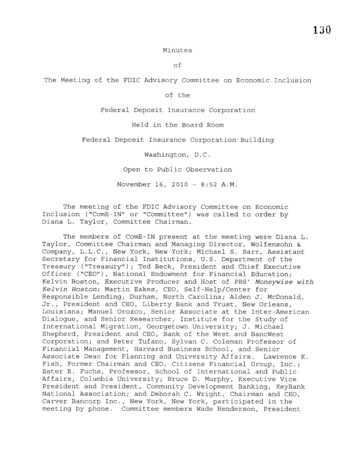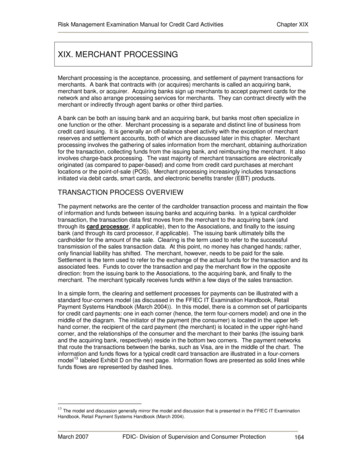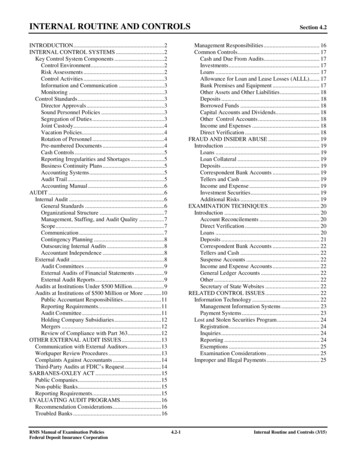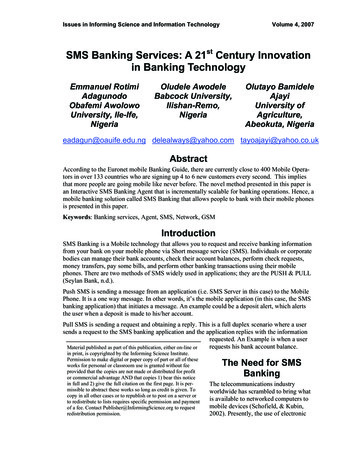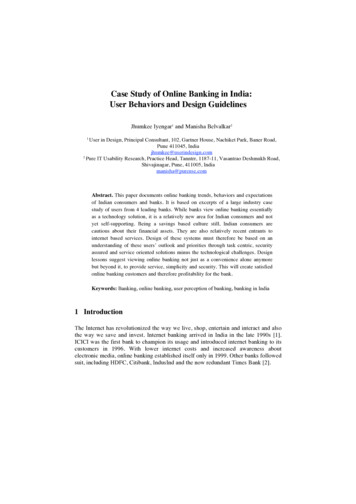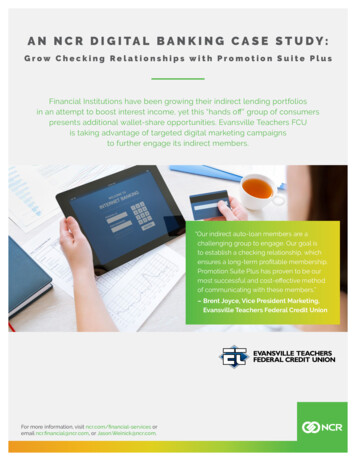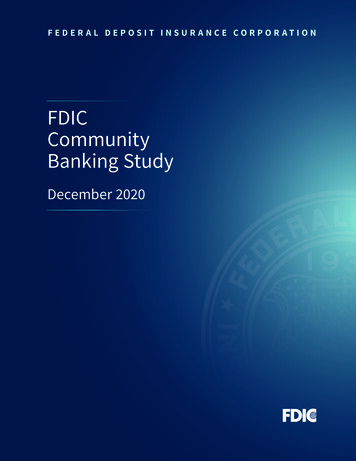
Transcription
FEDER AL DEPOSIT INSUR ANCE CORPOR ATIONFDICCommunityBanking StudyDecember 2020
Table of ContentsForeword. . . . . . . . . . . . . . . . . . . . . . . . . . . . . . . . . . . . . . . . . . . . . . . . . . . . . . . . . . . . . . . . . . . . . . . . . . . . . . . . . . IAcknowledgements . . . . . . . . . . . . . . . . . . . . . . . . . . . . . . . . . . . . . . . . . . . . . . . . . . . . . . . . . . . . . . . . . . . . . . . IIIExecutive Summary. . . . . . . . . . . . . . . . . . . . . . . . . . . . . . . . . . . . . . . . . . . . . . . . . . . . . . . . . . . . . . . . . . . . . . . . VChapter 1: Community Bank Financial Performance . . . . . . . . . . . . . . . . . . . . . . . . . . . . . . . . . . . . . . . . . 1-1Chapter 2: Structural Change Among Community and Noncommunity Banks . . . . . . . . . . . . . . . . . . 2-1Chapter 3: The Effects of Demographic Changes on Community Banks . . . . . . . . . . . . . . . . . . . . . . . . 3-1Chapter 4: Notable Lending Strengths of Community Banks. . . . . . . . . . . . . . . . . . . . . . . . . . . . . . . . . . 4-1Chapter 5: Regulatory Change and Community Banks . . . . . . . . . . . . . . . . . . . . . . . . . . . . . . . . . . . . . . . 5-1Chapter 6: Technology in Community Banks . . . . . . . . . . . . . . . . . . . . . . . . . . . . . . . . . . . . . . . . . . . . . . . . 6-1Bibliography. . . . . . . . . . . . . . . . . . . . . . . . . . . . . . . . . . . . . . . . . . . . . . . . . . . . . . . . . . . . . . . . . . . . . . . . . . . . . . . iAppendix A: Study Definitions. . . . . . . . . . . . . . . . . . . . . . . . . . . . . . . . . . . . . . . . . . . . . . . . . . . . . . . . . . . . . A-1Appendix B: Selected Federal Agency Actions Affecting Community Banks, 2008–2019. . . . . . . . . . B-1FDIC Community Banking Study December 2020
ForewordEight years ago, coming out of the financial crisis, thethroughout this country, which is why I made this updateFDIC conducted a study of community banks. This studyto the 2012 Community Banking Study a research prioritywas the first large-scale review of community banks everin 2020. I instructed my research team not only to updateconducted, and it recognized the importance of communitykey aspects of the prior study, but also to consider newbanks and their unique role in the banking industry. Astopics that are important to community banks, sucha result of that study, the FDIC changed its approach toas regulatory change and technology. By continuing toidentifying community banks. In general, communitystudy community banks and providing that researchbanks are those that provide traditional banking servicesto the public—our stakeholders—we can continue toin their local communities. As of year-end 2019, there wereidentify ways that the FDIC can provide support to4,750 community banks in the country with more thanthese institutions.29,000 branches in communities from coast to coast.I would like to extend a special thanks to Diane Ellis,Since the 2012 study, community banks have proven to beDirector of the FDIC Division of Insurance and Research,resilient. Relative to noncommunity banks, communityfor leading this effort.banks have had faster growth in return on assets ratios,higher net interest margins, stronger asset quality,I believe this work will provide continued recognitionand higher loan growth rates. Community banks haveof community banks’ strength, their unique role in thecontinued to demonstrate this strength during thebanking industry, and their value to the public.COVID-19 pandemic.Jelena McWilliamsThe FDIC recognizes the role community banks playChairman, FDICin providing loan and deposit services to customersDecember 2020FDIC Community Banking Study December 2020 I
AcknowledgementsThe FDIC Community Banking Study is a collaborativeDoreen Eberley, Keith Ernst, Pamela Farwig, Edwardeffort to identify and explore issues and questions aboutGarnett, Robert Grohal, Don Hamm, Angela Herrboldt,community banks. The study was produced under theTravis Hill, Deborah Hodes, Alex LePore, Kim Lowry,leadership of Shayna M. Olesiuk of the FDIC’s DivisionAshley Mihalik, Jonathan Miller, Patrick Mitchell, Sumayaof Insurance and Research. John M. Anderlik, MargaretMuraywid, Thomas Murray, Robert Oshinsky, CamilleHanrahan, and Benjamin Tikvina managed the study.Schmidt, Philip Shively, Michael Spencer, Aaron Wishart,and Katrice Yokley.The study’s primary authors are as follows:Chapter 1: Community Bank Financial PerformanceChristopher J. RaslavichChapter 2: Structural Change Among Community andNoncommunity BanksEric C. BreitensteinChapter 3: The Effects of Demographic Changes onI am also grateful to FDIC staff and contractors whoprovided valuable research, analytical, editorial, technical,and publication support, including Vaishali Ashtakala,Jeffrey Ayres, Jeffrey DeLuca, Olayemi Jegede, AlexanderGilchrist, Alan Levy, Jane Lewin, Lynne Montgomery, ChrisNardi, Daniel Nguyen, James K. Presley-Nelson, Shawn E.Schreier, David Spanburg, Derek Thieme, Jose M. Torres,Donna Vogel, Daniel Weeks, and Kathy Zeidler.Community BanksChester PolsonChapter 4: Notable Lending Strengths ofCommunity BanksRobert M. DiChiaraMargaret HanrahanRichard D. Cofer Jr.Chapter 5: Regulatory Change and Community BanksGeorge FrenchChapter 6: Technology in Community BanksDaniel HoopleI would like to thank the many senior officials and stafffrom the FDIC who provided valuable insights and feedbackduring the review of the study, including Leonard Chanin,FDIC Community Banking Study December 2020 The authors thank Brennan Zubrick, Kyle Zhong, and theConference of State Bank Supervisors for permission to usesurvey data from the National Survey of Community Banks.Finally, we are immensely grateful to the late RichardA. Brown, FDIC Chief Economist, for his leadership andcontributions to the study of community banking atthe FDIC, including leadership of the foundational 2012Community Banking Study, development of the communitybank definition, and nearly a decade of research andanalysis on the topic. Rich made lasting contributionsto the FDIC mission and was in our thoughts as we puttogether this study. He will be missed.Diane Ellis, DirectorDivision of Insurance and ResearchIII
Executive SummaryThe 2020 Community Banking Study is an update to theDuring the period 2012–2019, community banks narrowedFederal Deposit Insurance Corporation’s (FDIC) firstthe earnings gap with noncommunity banks because ofcommunity banking study, published in 2012, and coversfactors such as a wider net interest margin and strongerthe period from year-end 2011 through year-end 2019. Thecredit quality. Community banks ended 2019 with aearlier work made several important contributions to ourquarterly pretax ROA ratio of 1.44 percent, only 22 basisunderstanding of the performance of community bankspoints below the pretax ROA ratio of noncommunity banks,and the significant role they play in the banking systema significant improvement from the 43 basis point gap atand the nation’s economy. It also established a definitionyear-end 2012. Community banks maintained their marginof a “community bank” that was not solely driven byadvantage by earning higher yields on earning assets,asset size but also incorporated a bank’s business plan,which was partly attributable to their holding a highergeographic footprint, and number of branches (Appendixshare of longer-term assets than noncommunity banks.A). This study retains the definition established in theCommunity banks also maintained their asset qualityearlier edition and updates several areas of analysisadvantage over noncommunity banks as measured byincluding community bank financial performance, trendscredit losses. The full-year net charge-off rate reported byin community bank consolidation, and communitycommunity banks reached a post-crisis low of 0.13 percentbank lending focus. The current study also extends thein 2019, which was 45 basis points below the rate reportedconversation about community banks in several directions:by noncommunity banks.it broadens the analysis of demographic changes affectingcommunity banks and the products and services theyOne area that noncommunity banks outperformedoffer, and it provides both an analysis of the effect ofcommunity banks was noninterest expenses.regulatory changes on community banks and an account ofNoncommunity banks were able to reduce overheadcommunity banks’ adoption of new technologies. Finally,expenses from 3.01 percent of average assets as of year-endeach chapter in this study concludes by suggesting—from2012 to 2.61 percent of average assets as of year-end 2019.the perspective of the subject of the particular chapter—Community banks saw their overhead ratio decline frompossible effects the COVID-19 pandemic could have on3.13 percent to 2.83 percent during the same time period.community banks.Community Bank Financial PerformanceStructural Change Among Community andNoncommunity BanksCommunity banks continued to report positive financialAfter the 2012 study the banking industry continued toperformance, including improving pretax return onconsolidate, but existing community banks were lessassets (ROA) ratios, a wide net interest margin, andlikely to close than noncommunity banks. Of the 6,802strong asset quality indicators. Coming off the recessioninstitutions identified as community banks at year-endthat ended in 2009, community bank pretax ROA ratios2011, just under 30 percent had closed by year-end 2019.1steadily improved, increasing from 1.05 percent in 2012In comparison, over the same period, more than 36 percentto 1.44 percent in 2019. The improvement in earningsof the 555 institutions that identified as noncommunitywas widespread with over 60 percent of communitybanks had closed. Including institutions that werebanks reporting increases from 2009 through 2019.community banks at year-end 2011 but noncommunityCommunity banks’ earnings performance, moreover,banks at year-end 2019 and vice versa, as well as banksimproved relative to noncommunity banks. By certainnewly chartered between 2012 and 2019, there weremeasures, particularly pretax ROA, community banks have4,750 community banks and 427 noncommunity banks atlong underperformed noncommunity banks. The mostyear-end 2019.important factor contributing to the earnings gap betweencommunity and noncommunity banks had been the abilityof noncommunity banks to generate noninterest income—primarily from investment activities that typically are notpart of the traditional community banking business model.FDIC Community Banking Study December 2020 The 2012 Community Banking Study reported 6,799 communitybanks and 558 noncommunity banks. These numbers have changedslightly reflecting new and revised Call Report filings that causeddesignation changes.1V
The drivers of banking consolidation shifted after the 2012population inflows—community banks grew quickly andstudy. In that study, we showed how consolidation betweenprofitably and supported communities with commercial1984 and 2011 for both community and noncommunityand industrial (C&I) and commercial real estate (CRE) loansbanks was driven by failures and charter consolidation.to help areas continue to grow. Areas with net outflows,Between 2011 and 2019, a period of economic recovery,on the other hand, appear to experience demographic andfailures declined substantially, voluntary mergers betweeneconomic headwinds, causing banks in those countiesunaffiliated institutions increased and became theto grow more slowly and have lower commercial lendingpredominant cause of the decline in the number of insuredportfolios—conditions that could weigh on communitydepository institutions, and mergers between institutionsbanks in those areas. These demographic trends could alsothat were part of the same holding company fell. Theresult in greater consolidation in the future.major contributor to the overall decline, however, was thehistorically low number of newly chartered institutions:between 1985 and 2011, 183 new institutions were charteredper year on average, compared with four per year between2012 and 2019. This combination of factors pushed up therate of net consolidation for the banking industry between2012 and 2019 to 4.3 percent, compared with its average of3.2 percent during the years 1985 to 2011.The Effects of Demographic Changes onCommunity BanksThe changing demographic makeup of the UnitedStates affects demand for community bank services:as demographics change, banks see changes in theirclient bases and in the demand for loans. Two majordemographic factors considered in this study are medianage and net migration flows. A comparison with thecommunity-bank industry as a whole shows that between2011 and 2019, community banks that were headquarteredin counties at one demographic extreme—counties withlower median ages and the highest levels of net migrationinflows—experienced faster asset and loan growth rates,were more profitable, and had larger shares of businessloans. Such counties tended to be in metropolitan areas. Atthe same time, community banks that were serving areasof the country at another demographic extreme—countieswith higher median ages and the highest levels of netmigration outflows—experienced fewer opportunities forgrowth. Such counties tended to be in rural areas.Community banks headquartered in areas simultaneouslyexperiencing two distinct demographic trends nonethelesssaw consolidation trends that were similar to trends in theindustry as a whole. As a result, these counties’ share ofthe total banking industry headquarters remained stable.In areas of the United States that were arguably mostthriving—those with a younger population and netVI Notable Lending Strengths ofCommunity BanksCommunity banks by count represent the vast majorityof banks in the United States. By other size measures,however, community banks represent a considerablysmaller share: in 2019, they had only 12 percent of totalindustry assets and 15 percent of total industry loans.Despite holding a small share of total loans, communitybanks are a key provider of funding for many localbusinesses, most importantly by making CRE loans, smallbusiness loans, and agricultural loans.CRE LendingCRE loans provide opportunities for businesses to owncommercial property, for housing within communities,and for the provision of retail and other services tometropolitan, micropolitan, and rural areas. Communitybanks are an important source of financing for CRE asevidenced by these banks’ loan portfolios, the types ofproperties they finance, and the myriad locations of theproperties financed. The share of CRE loans communitybanks hold (30 percent of the banking industry’s CREloans) is large relative to the banks’ representation in thebanking industry. CRE lending also is widely distributed,with almost all community banks holding at least someamount of CRE loans, and many holding substantialportfolios. Community banks originate various types ofCRE loans: multifamily lending grew in the years between2011 and 2019, and community banks are active lenders toa wide range of industries, including industrial, retail, andhotel industries.In addition to lending across industry types, communitybanks have been active CRE lenders across all sizes ofmarkets. In 2019, community banks headquartered in ruraland small metropolitan areas held more than two-thirds ofCRE loans held by all banks headquartered in those smallerFDIC Community Banking Study December 2020
geographic areas. In larger metropolitan areas, communitybanks’ share of loans was smaller, but still material.Although community banks of all lending specialtiesprovide CRE financing, the share of community banks thatare CRE specialists increased during the period between2012 and 2019.2 These CRE specialists are importantproviders of CRE loans in small communities.As important providers of CRE financing, communitybanks are among those lenders interested in CRE marketdynamics in the years ahead. As of the beginning of 2020,the long economic expansion had been a positive backdropto CRE. Delinquency rates among community banks’ CREloan portfolios had declined for much of the previousdecade, and at the end of 2019, the average delinquencyrate had settled at a very low level.Agriculture LendingCommunity banks are an important source of financingfor U.S. agriculture, funding roughly 31 percent of farmsector debt in 2019, with half of that total financed bycommunity-bank agricultural specialists. The lendingemphasis of community-bank agricultural specialistslargely played in their favor from 2004 through 2013.Community-bank agriculture specialists’ exposure to thenegative credit effects of the housing crisis and recessionthat followed was minimized, and instead they benefitedfrom a strong, decade-long farming boom. Beginningin 2014, the agriculture sector struggled in terms ofprofitability, but erosion in farm financial conditionswas gradual and generally modest. Credit quality atcommunity-bank agricultural specialists weakenedbut still remained favorable by long-term historicalSmall Business Lendingcomparison, and earnings and capital were strong.Small businesses are key to the U.S. economy, representingCommunity-bank agricultural specialists tend to bethe vast majority of all businesses by count and employingsmall; in 2019, more than 75 percent had total assetsalmost half of the private sector workforce. Theseunder 250 million, and just 19 out of 928 community-businesses often need funding, for example for inventory,bank agricultural specialists had total assets in excess ofworking capital, or accounts receivable financing. 1 billion. Geographically, community-bank agriculturalDespite holding only 15 percent of total industry loans inspecialists were heavily concentrated in the center of the2019, community banks held 36 percent of the bankingcountry. Agriculture in this area is dominated by cattle,industry’s small business loans.3 Community banks focuscorn, hogs, and soybeans and to a lesser extent cotton,on building relationships with small business ownersdairy, poultry, and wheat.and tend to make loans that require more interactionwith the borrower. By contrast, noncommunity banks,Community-bank agricultural specialists have shown awhich dominate the smallest category of business loanstrong commitment to lending to farmers through theoriginations—loans below 100,000 that are typicallypeaks and valleys of cycles in the agricultural sector. Frombusiness credit card lines—tend to use a scoring modelfirst quarter 2000 through fourth quarter 2019, in only twothat requires little interaction with customers.4 Duringquarters did community-bank agricultural specialists seethe period covered by this study, community banks’an annual decline in aggregate agricultural production loanshare of small business loans per Call Report data hasvolume, and never in aggregate farmland-secured loans.declined. Small Business Administration 7(a) programloan originations increased from 38 percent of totaloriginations in 2012 to 46 percent in 2019 with many loansRegulatory Change and Community Banksgreater than 1 million originated. Finally, in responseThe period 2008–2019 was one of intense regulatoryto the 2018 FDIC Small Business Lending Survey, manyactivity, much but not all of it in response to the 2008–2013bankers said their C&I loans were e
FDIC CommunIty BankIng StuDy DeCemBer 2020 V Executive Summary The 2020 Community Banking Study is an update to the Federal Deposit Insurance Corporation’s (FDIC) first community banking study, published in 2012, and co
